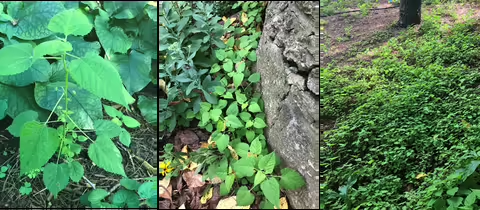I really can’t say enough bad things about mulberryweed, a.k.a. hairy crabweed (Fatoua villosa). For me, it has been a weed nightmare that come in on a load of mulch about 10 years ago, and every year since has been a battle to control because I didn’t recognize it for what it was and take action soon enough. Hand weeding or chemical control needs to be done immediately upon detection, and this can’t be stressed enough.
Mulberryweed, as its name implies, is a member of the mulberry family. It is an erect, branching summer annual weed most commonly found in landscapes and containerized plants. It thrives in mixed plantings where it is difficult to safely use postemergent herbicides, resulting in a lot of hand weeding. Native to eastern Asia, it is thought to have hitched a ride to the southern US in the latter half of the 20th century and has been on the move ever since. It has the ability to reproduce and spread so rapidly, I’ve started jokingly referring to it as the “tribble” of weeds, in reference to the fictitious animal portrayed on the original Star Trek series. Unlike a tribble though, mulberryweed isn’t born pregnant; just seems that way because the plant can produce seed when only a few inches tall... by the three-leaf stage of growth! So in one season, several generations can and did multiply exponentially in my jungle. It is best adapted to moist, shady conditions which works against a gardener trying to get it under control. When weeding, it is important to canvas every inch under desirable plants because there just might be a mulberryweed hiding from detection. The seed does requires light to germinate, so one of the mitigation options is to apply a 2-3” mulch layer after weeding to block light. This works rather well if your mulch is free of seeds itself, so steer clear of “free” mulch that has any evidence of mulberryweed growth prior to loading up. I have found from experience that when you don’t mulch or put down a pre-emergent herbicide immediately after weeding, you most likely will be coming back at a later date to do it all over when remaining seed germinate. This weed is really cagey too. If you don’t hoe it off cleanly or pull it out by its roots, it is readily capable of regrowth. In fact, it is more than happy to break off in your hand, hoping you won’t come back for the rest of it. I have learned to pinch and pull at the base, and not pull from the middle or the top of the plant. It is reported that most seeds drop close to the mother plant, but some are dehiscent (splitting or bursting open) and capable of shooting up to 4 feet away, so this plant has definitely evolved to survive. Inspect all container plants for evidence of this weed before planting. If you do find one, scrape away at least the top ½” in an effort to remove and destroy any seeds left behind. You do not want this in your landscape!
